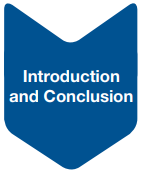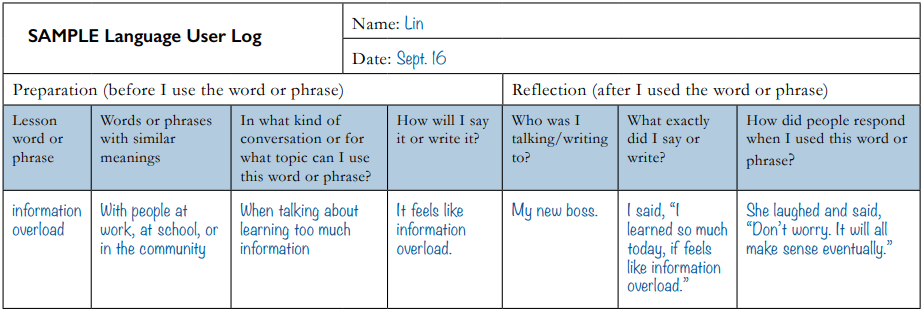Appendix 3: Strategy Coach Tips
46 Chapter 1: Strategy Coach Tips
1.1 Strategy Coach Tip
 |
Start by looking at the features of the text and thinking about them. Look for things that help important points stand out, such as the title, headings, or text with bullet points or numbers. In the text that follows, look at the title. |
 |
Next, look for pictures or images. Pictures, diagrams, charts, graphs, or maps are often used to highlight key points in a text. In the text that follows, look at the image in the box about the mission statement and values. |
 |
Then read the introduction and the conclusion of the text. The introduction and concluding parts of a text give you clues about what the rest of the information is about. The introduction usually presents the main information that will be discussed in detail later on in the document. The concluding part will usually give you a summary. |
1.2 Strategy Coach Tip
Guessing new words 
Checking the meaning of every word in a text that you do not understand will slow you down. You can use the other words in the text to guess the meaning of a word you don’t know. This is a very important strategy to develop. Look at the words in the sentences before and after the word that you do not know for clues to help you guess the meaning.
1.3 Strategy Coach Tip
Types of words 
There are different types of words in English. Each type of word has a job, or a function. Here we will learn about three types of words: nouns, verbs and adjectives.
| Type of Word | Function | Example | Example sentence |
|---|---|---|---|
| Noun | Names a thing, person, place, or idea | table, man, woman, room, hapiness | A man and a woman are sitting at a table. |
| Verb | Describes an action
(doing) or a state (being) |
go, come, sit, is (be) | The man and woman go home at 6:00. He is a teacher. |
| Adjective | Describes a noun | big, small, beautiful | The Rockies are beautiful. He is a good man. |
1.4 Strategy Coach Tip
Predicting helps with understanding 
Predicting, or thinking about what you are going to hear, will help you notice
- the knowledge you already have about the topic
- the vocabulary you already have about the topic
You might use the strategy of predicting at work; for example, to prepare before going to a meeting.
1.5 Strategy Coach Tip
Read the questions first 
Reading the questions before you listen to the audio in a listening activity is a good strategy. If you read the questions first, you will get an idea what the listening excerpt will be about. You are also more likely to notice the answers while you are listening. This is also a valuable strategy for taking tests; read the questions first so you know what to listen for.
1.6 Strategy Coach
Understanding the order of instructions 
When people give instructions, they usually make the order clear for the listener or reader. They do this by using words that show sequence or order. Here is a short lesson on this.
Sequence markers:
- When people give instructions or explain how to do something, they often use signal words or phrases to show the order in which things should happen.
- These signal words or phrases help the person listening or reading to understand the process.
- Pay attention to the words in blue in the example that follows.
First, sign in before you start working. Next, check to see if the people who worked before you have left any notes about tasks they were unable to complete. After that, complete the tasks in the notes. Once you have completed the tasks in the notes, move on to your other tasks. Finally, at the end of your shift, leave a note for the person working next.
Timeline of tasks:
- Here is a timeline showing the order in which the tasks should be done.
- Does it match the text you just read?
Start working
Check for notes
Complete tasks in notes
Move on to other tasks
Leave a note at the end of shift
Here are some common sequence markers you can use:
| Sequence marker | Example | Function |
|---|---|---|
| First
Second Third… |
First, fill in your first and last name. Second, fill in your address. Third, fill in your telephone number. | To show the step-by-step order in a sequence. |
| Next
Then After that |
First, start the computer. Next, sign in. After that, check your emails. Then, respond to your emails. Finally, log out. | To show the order of things between the start and the finish. |
| Finally | First, fill in the form. Next, sign it. Then, scan it. Finally, email it to the supervisor. | To show that something is the last step in a process. |
| Once
When |
Once you have finished your shift, sign out. When your report is complete, submit it to a supervisor. | To show that one action happens only after another one is finished. |
| While + action | Make sure the doors are locked while you are doing the security check. | Show that one action happens at the same time as another. |
Watch and listen for sequence markers in the listening activities and pay attention to how they help you understand the order in which things should be done.
1.7 Strategy Coach Tip
Listening for thought groups 
When people speak in sentences in English, they chunk, or group words together, in thought groups. If you listen carefully for pauses in speech, you can identify how the words are grouped together.
1.8 Strategy Coach Tip
Making connections in dialogues and clarifying information
Making connections in dialogues 
When speaking or writing in English, people generally make connections between points so that the listener or reader can understand what they are saying.
In a dialogue, we can hear these connections in different ways.
Here are a few examples:
- I read three books last month. Two were great.
- The connection is made through the reference to numbers.
- We will go over a number of topics today
- The first topic is parking.
- The connection is made through the reference to the topics.
- A: Have you been here long?
- B: Close to seven years.
- The connection is made through the reference to time in the question and the answer.
Think about these connections while arranging the parts of the dialogue.
Clarifying information 
Remember in the listening activity where Raja and Paul repeated information and used direct questions to clarify information or double-check that they understood what Sima said?
Clarifying information is especially important in the workplace when someone is giving instructions or sharing important information.
Watch for more examples of clarifying information in the speaking activity that follows.
1.9 Strategy Coach Tip
Learning new vocabulary 
Learning a language doesn’t only happen in a classroom. One of the best ways to learn how to use new words and expressions is to log, or record, how people use these words in daily life. Try to use the new words yourself, and keep track of how you use them. The more you use the new words, the easier they will be for you to remember and understand.
There are two kinds of language logs to help you develop your vocabulary:
1. Language Observer Log: In this log, you can record where you heard or read the word or phrase. Read this sample Language Observer Log and discuss it with your instructor or classmate.

2. Language User Log: In this log, you can record how and where you used the word or phrase. You can also analyze how you used it. Read this sample Language User Log and discuss it with your instructor or classmate.



